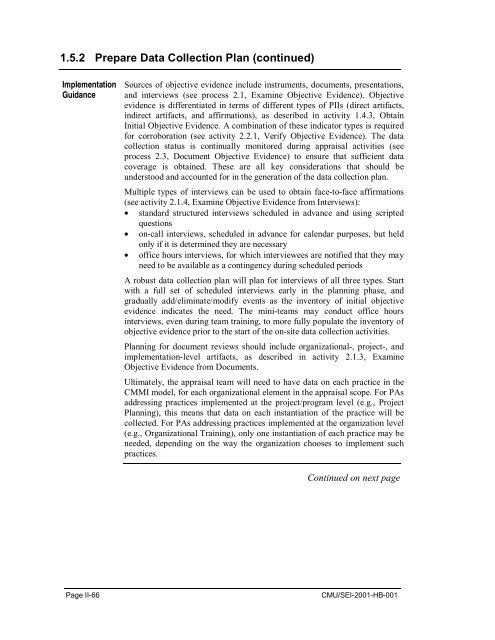Standard CMMI Appraisal Method for Process Improvement (SCAMPI)
Standard CMMI Appraisal Method for Process Improvement (SCAMPI)
Standard CMMI Appraisal Method for Process Improvement (SCAMPI)
Create successful ePaper yourself
Turn your PDF publications into a flip-book with our unique Google optimized e-Paper software.
1.5.2 Prepare Data Collection Plan (continued)<br />
Implementation<br />
Guidance<br />
Sources of objective evidence include instruments, documents, presentations,<br />
and interviews (see process 2.1, Examine Objective Evidence). Objective<br />
evidence is differentiated in terms of different types of PIIs (direct artifacts,<br />
indirect artifacts, and affirmations), as described in activity 1.4.3, Obtain<br />
Initial Objective Evidence. A combination of these indicator types is required<br />
<strong>for</strong> corroboration (see activity 2.2.1, Verify Objective Evidence). The data<br />
collection status is continually monitored during appraisal activities (see<br />
process 2.3, Document Objective Evidence) to ensure that sufficient data<br />
coverage is obtained. These are all key considerations that should be<br />
understood and accounted <strong>for</strong> in the generation of the data collection plan.<br />
Multiple types of interviews can be used to obtain face-to-face affirmations<br />
(see activity 2.1.4, Examine Objective Evidence from Interviews):<br />
• standard structured interviews scheduled in advance and using scripted<br />
questions<br />
• on-call interviews, scheduled in advance <strong>for</strong> calendar purposes, but held<br />
only if it is determined they are necessary<br />
• office hours interviews, <strong>for</strong> which interviewees are notified that they may<br />
need to be available as a contingency during scheduled periods<br />
A robust data collection plan will plan <strong>for</strong> interviews of all three types. Start<br />
with a full set of scheduled interviews early in the planning phase, and<br />
gradually add/eliminate/modify events as the inventory of initial objective<br />
evidence indicates the need. The mini-teams may conduct office hours<br />
interviews, even during team training, to more fully populate the inventory of<br />
objective evidence prior to the start of the on-site data collection activities.<br />
Planning <strong>for</strong> document reviews should include organizational-, project-, and<br />
implementation-level artifacts, as described in activity 2.1.3, Examine<br />
Objective Evidence from Documents.<br />
Ultimately, the appraisal team will need to have data on each practice in the<br />
<strong>CMMI</strong> model, <strong>for</strong> each organizational element in the appraisal scope. For PAs<br />
addressing practices implemented at the project/program level (e.g., Project<br />
Planning), this means that data on each instantiation of the practice will be<br />
collected. For PAs addressing practices implemented at the organization level<br />
(e.g., Organizational Training), only one instantiation of each practice may be<br />
needed, depending on the way the organization chooses to implement such<br />
practices.<br />
Continued on next page<br />
Page II-66<br />
CMU/SEI-2001-HB-001
















